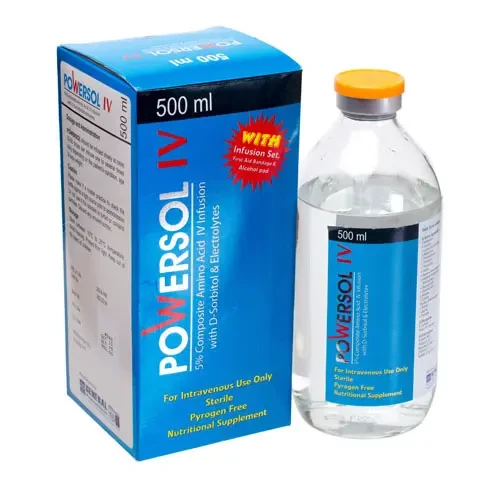Powersol Uses, Dosage, Side Effects and more
Amino Acids is a sterile aqueous solution, consisting of crystalline amino acids and D-sorbitol with electrolytes. Amino Acids is necessary as the nitrogen sources for parenteral nutrition in which nitrogen is provided in the form of essential and non-essential amino acids. The solution is clear, colorless having a pH lying in the range of 5.7 to 7.0.
CompositionEach 100 ml contains:
i) Active ingredients Specification Quantity
L-Isoleucine USP 0.352 gm
L-Leucine USP 0.490 gm

| Attribute | Details |
|---|---|
| Trade Name | Powersol |
| Generic | Amino acids |
| Amino acids Other Names | Amino acids NOS |
| Weight | 5% |
| Type | IV Infusion |
| Groups | Investigational |
| Therapeutic Class | Parenteral Nutritional preparations |
| Manufacturer | General Pharmaceuticals Ltd |
| Available Country | Bangladesh |
| Last Updated: | January 7, 2025 at 1:49 am |
Uses
Amino Acids is used for a source of amino acids for protein synthesis in patients needing intravenous nutrition. It is particularly suitable for a patient with basal amino acid requirements. Amino Acids is also used for faster recovery in surgery, burns, renal insufficiency, hepatic insufficiency and effective management of Cancer.
Powersol is also used to associated treatment for these conditions: Creatinine Clearance 5-15 mL/min, Uremia, Nutritional Support, Parenteral Nutrition, Total parenteral nutrition therapy
Dosage
Adults:
The nitrogen requirement for maintenance of body protein mass depends on the patient's condition (nutritional state and degree of metabolic stress).
No or minor metabolic stress and normal nutritional state: 0.10-0.15 g nitrogen/kg/day,
Moderate metabolic stress with or without malnutrition: 0.15-0.20 g nitrogen/kg/day,
Severe catabolism as in burns, sepsis and trauma: up to 0.20-0.25 g nitrogen/kg/day.
The dosage range 0.10-0.25 g nitrogen/kg/day corresponds to 15-35 ml Amino Acids/kg/day.
In obese patients, the dose should be based on the estimated ideal weight. Depending upon patients requirements, 1000-2000 ml Amino Acids may be infused intravenously per 24 hours. Amino Acids should be infused slowly, at rates 1.4-2.8 ml (30-60 drops) per minute.
Infants and Children:
In children and infants, the rate of infusion is 28-35 ml/kg body wt/day is recommended, with a stepwise increment in the rate of administration during the first week of treatment.
How Long Does It Take to Work?
How Long Does It Take to Work? see here Powersol
Side Effects
Amino Acids is usually well tolerated. Yet nausea, vomiting, flushing and sweating have been observed during infusion of Amino Acids at rates exceeding the recommended maximal rate. Hypersensitivity reactions have been reported. Like all hypertonic infusion solution, thrombophlebitis may occur when peripheral veins are used. The incidence may be reduced by the simultaneous infusion of 10% fat emulsion. If it is infused to severely ill patients, premature infants, hyperphenylalaninemia may occur.
Precaution
Hyperphenylalaninemia has been noted in severely ill, premature infants. In these patients, monitoring of the phenylalanine levels is recommended and the infusion rate adjusted as needed.
Do not use if the solution is turbid or contains particles. Discard any unused portion.
Pregnancy & Breastfeeding use
Successful and safe administration of amino acid solutions during pregnancy in the human has been reported. Animal reproduction studies have not been carried out with Amino Acids.
Contraindication
Amino acid is contraindicated in patients with inborn errors of amino acids metabolism, irreversible liver damage and severe uremia when dialysis facilities are not available.
Special Warning
In children and infants, the rate of infusion is 28-35 ml/kg body weight per day is recommended, with a step wise increase in the rate of administration during the first week.
Storage Condition
Protect from light and store between 15-25 °C temperature. Avoid freezing. Keep medicament's out of reach of children.



